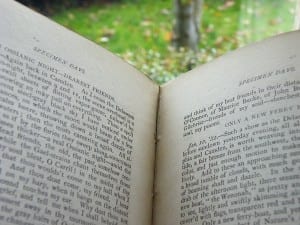London-born and based Caroline Jane Harris, shortlisted for the Aesthetica Art Prize 2024, responds to universal experiences of nature, capturing visual phenomena found in all levels of existence across time and cultures. Her fragile hand-cut pictures reflect an anxiety around the decline of physical images in the digital realm, and also perpetual innovation and destruction in the Information Age. A Stopped World derives from online videos featuring volcanic eruptions that were screen-captured, enlarged, printed and cut out in pixelation. These spectacular phenomena have become compressed, turning disasters into distractions. It’s a process that speaks to our mediated experience of nature online.

A: What is the key idea behind A Stopped World?
CJH: I like to think that my work, like my process, is multi-layered, so it makes more sense to speak of recursive key ideas: nature, time, technology and image-making. I make multiple reproductions where nature is a form of inspiration, awe and an affective device. In so doing, I examine our relationship to the environment, and our mutual fragility. I also contemplate our place in the universe: our connection with the cosmos, the rhythms of birth and death, and qualities of interconnectedness. I draw upon time as a universal human experience, but also deep time, manipulating images to condense past and present. I reflect upon how speed and attention represent our values, and the role of accelerating technologies in shaping our culture and experiences. I champion traditional techniques whilst dissecting digital images, using intricate and meditative processes to, in a small way, impart peace onto myself and the world.
A: Can you walk us through the process of making the piece? How long did it take?
CJH: The process is complex, so bear with me! An online video of a volcanic eruption seized my attention visually, materially and allegorically. I went about capturing the video at roughly one second intervals using the imprecise technique of tapping shift + command + 3. Here, the screenshot is a purely digital capture that further dematerialises the video, whilst also referencing cameraless photographs like photograms. These screenshots, including the black borders of the video, were then printed on 16 sheets of paper. The fourth still frame was blown up to the size of all the stills together as one grid, then printed again as a tiled image to become the background layer. The upper layer of these prints was cut-out by hand in a binary bitmap pattern which speaks to both digitisation and tradition: the image as 0s and 1s on the screen meets Asian woodblock reduction printing, which I studied for my undergraduate. A Stopped World took about three months; all the cut-pixels are gathered, dated and stored.
A: We live in an increasingly digital world. What does the future hand-crafting look like?
CJH: I was born in the late 1980s, so my first interactions with the internet and digital technologies coincided with my early teens – a pivotal period of time. My work straddles two epochs: pre- and post-digital. I am keenly interested in the co-existence of technologies, hybrids and cross-disciplinary practices. There is a material nature to be uncovered beyond digital existence and there are many artists exploring these realities in new and interesting ways. I hope to be in that cohort.
I consider it of paramount importance for art courses to continue to teach the relevance of tangible historical processes in today’s world of high-speed, simulated and disembodied encounters. The pandemic made us realise that we’re all interconnected, not just through global events and the internet, but through touch. The imprints we leave on the world, both physically and through our actions, create concentric circles that affect future generations. For better or worse, I feel touch is fundamental.
A: How does it compare to your other pieces of work? Is it similar, or different?
CJH: A Stopped World is the largest piece I have made to date. I had intended for some time to explore cinematic qualities with sequential images that envelop the field of vision. I am always trying to evolve my image-making through technical processes and ambitious new paths. Making this work during lockdown created a daily meditation and a goal that proved invaluable at the time; it seems inextricably linked to that moment. I’m always playing with fast and slow ways of seeing and creating tensions through exchanges between seemingly opposing elements: analogue and digital, material and immaterial, fast and still, sublime and everyday. Ultimately, however, I aim to transcend opposing archetypes and create a unifying, unhurried experience of awe: an alternative form of connection.

A: What are you most looking forward to about the Future Now Symposium and Art Prize Exhibition?CJH: Although it’s not my first time as a Finalist in Aesthetica Art Prize (I was shortlisted in 2013), it will be the first time attending the Symposium and Exhibition, so I’m highly anticipating seeing both my artwork in a different context and in England for the first time – it’s only been exhibited in Germany and Ireland so far – as well as the other Finalists’ pieces. It appears to be an exceptional group of artists from all over the world. I am going to speak at the Symposium, which is fairly daunting, but I also value the opportunity to connect on a more personal level with the audience and share with the other attendees.
Harris is part of the Aesthetica Art Prize 2024 Exhibition at York Art Gallery from 16 February – 21 April. Plus, meet over 250 longlisted international artists in our new online gallery.
Want to get involved? The next edition of the Prize is open for entries. Submit your work by 31 August. Win £10,000, exhibition and publication. Find out more here.
All images courtesy Caroline Jane Harris.




